Earwigs are creepy-looking insects that invade the houseplants and gardens. They eat your favorite indoor plants and yards and are only active at night. On the other hand, earwigs are beneficial when in small numbers because they feed on other damaging insect pests but become a real problem when in large numbers. Let’s learn how to get rid of earwigs in this write-up.
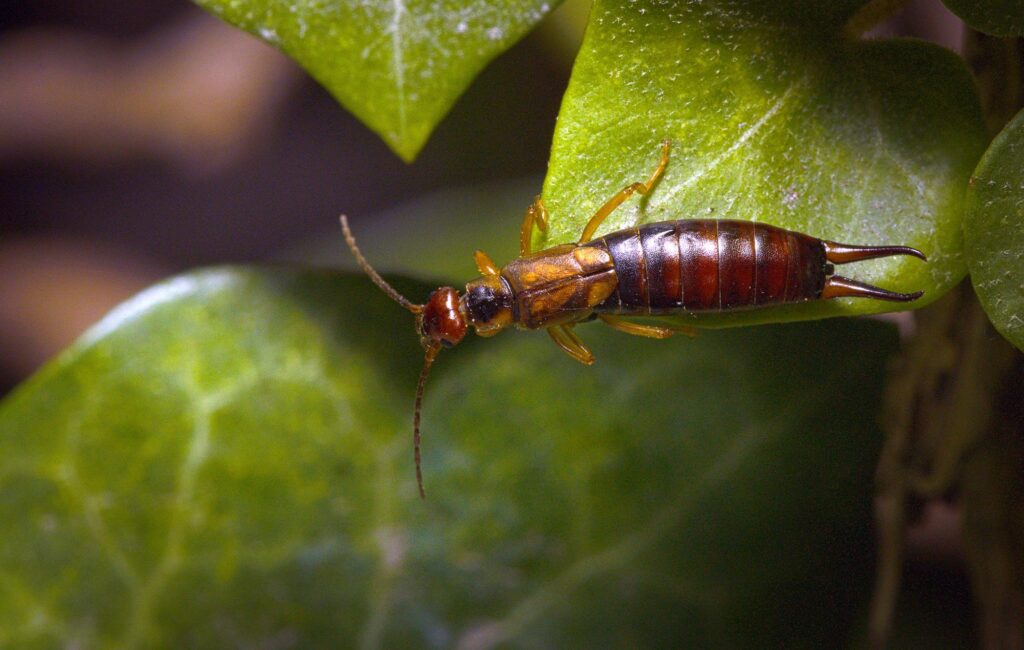
European earwig or Pincher bug on an English ivy leaves
What are Earwigs?
Earwigs are primarily active at night (nocturnal) and occupy the moist and wet places of gardens and potted plants. They are omnivorous, which means earwigs eat dead decaying wood, leaves, and other plant material. They hide in wood piles, leaf litter, and basements during the daytime.

Pincher bugs appear as dark brown, which reminds me of cockroaches.
They belong to the insect order Dermaptera. There are nearly 2000 species of them. Earwigs are also known as pincher bugs because of the two appendages or pinchers. These pictures are present on the back of their abdomen.
Note: The name “earwigs” comes from an old myth that means “ear wiggler.” It is believed that these insects seek human ears to live. In France, they are called “ear piercers,” and in Germany, they are called “earworms.”
Earwigs are considered natural composters and predators for most insect pests of houseplants and gardens. They feed on the aphids, larvae, slow-moving pests, and other armyworms and help the gardeners keep pests populations at lower levels.
Also, they feast on decaying organic matter and use it as hiding places during the daytime. In this way, they play a beneficial role in plant health and do not cause any damage to garden plants. However, keep a close eye on the earwig populations because they munch on young seedlings when they are in high numbers.
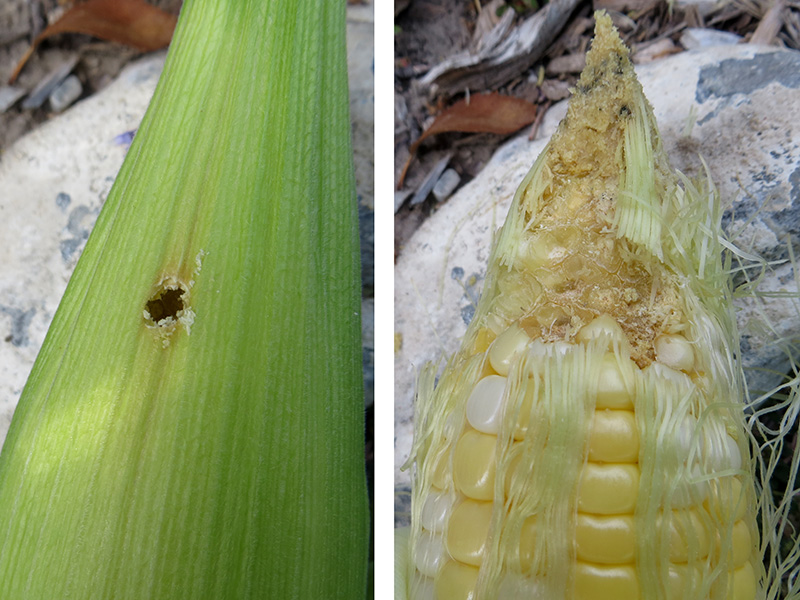
Earwig infestation leads to poor kernel development and eating holes in leaves.
Earwig infestations cause damage to corn silks and make small holes in flowers and leaves. They also impact pollination and lead to poor kernel development in corn crops.
Sometimes earwigs prefer to eat plant shoots, ripened fruits, and flowers. Therefore, always be wary about the earwig populations because they need instant pest control measures when their numbers explore.

Earwig infestation in bean crop
Moreover, earwigs can easily travel long distances by attaching or hiding in produce shipments.
Identification of Earwigs
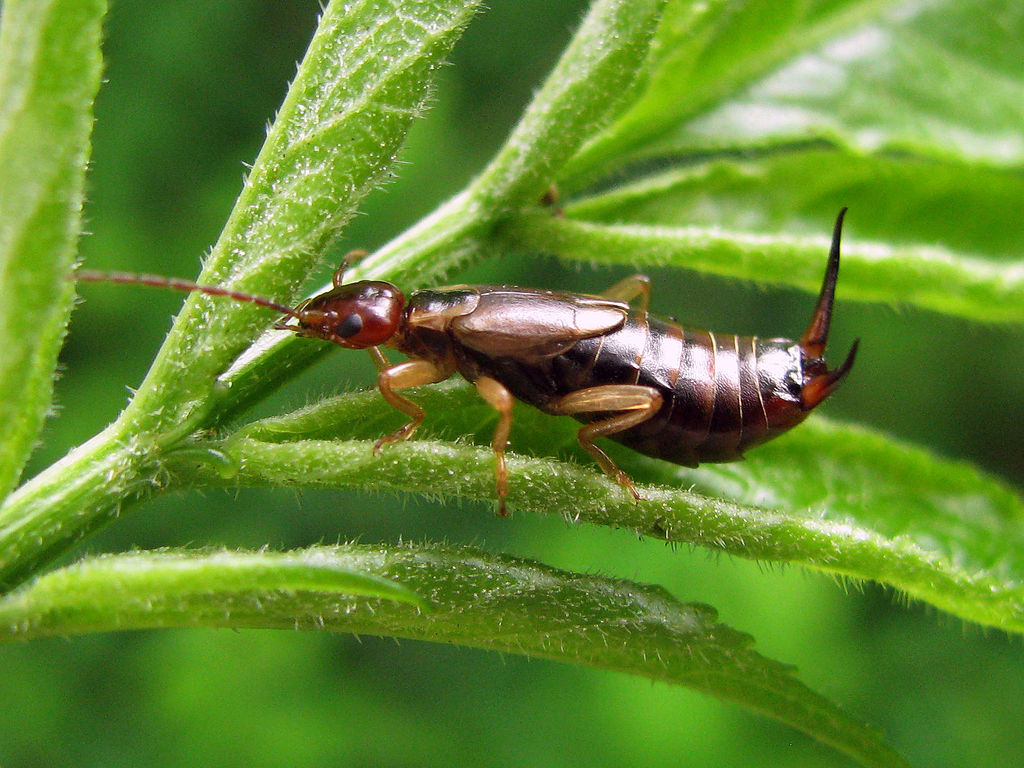
Female earwig in a defensive pose
These nocturnal bugs are reddish-brown with long, slender, and flattened bodies. They are the only members of the insect order Dermaptera and prefer places of excess moisture. Earwigs are almost 3 to 4 inches long and have specialized pichers at the tail side, used to capture the prey for defense and mating.
A few species of earwigs have wings, but they rarely fly. Mainly they crawl in search of their food and are not strong fliers. Due to the pincers, they do appear as scary, but earwigs are harmless to humans and pets.
Life Cycle of Earwigs
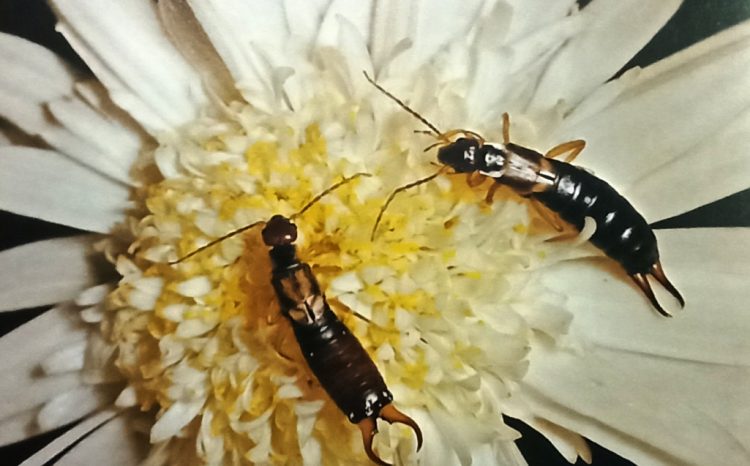
The adult male and female earwigs during the peak season of population growth
The active period for earwigs is early summer. The adults lay almost 20 to 30 creamy-white eggs in the underground nests. Female earwigs lay eggs in January and February. At the same time, the newly hatched larvae are protected in underground nests and only emerge during April.
When the young nymphs leave for a food search, they can fence the danger. After 4 to 5 nymphal molting, they turn into adults. The larvae are similar to adults in appearance and lack large wings and large appendages in the abdomen.
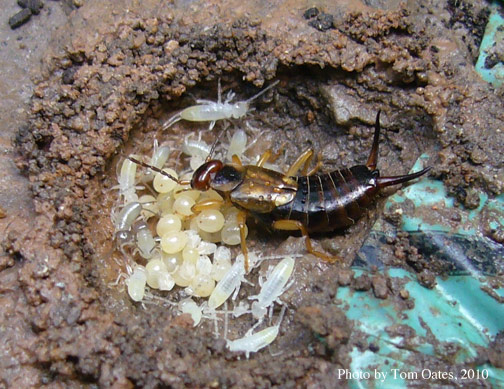
Female earwig with its eggs and young earwigs in an underground nest
Earwigs can have two generations per year under optimum flourishing conditions.
Note: Earwigs do not prefer indoor environments and their presence in interior spaces is accidental. They establish themselves outdoors for growth and reproduction.
How to Get Rid of Earwigs with Best Pest Control Strategies?
Although earwigs are not harmful, they may cause damage to your favorite vegetables and ornamentals. This is because they eat dead insects and decaying plant material in your gardens.
On the other hand, earwigs can damage corn crops and other garden vegetables. Therefore, it is wise to employ effective strategies to kill earwigs or keep them away.
The following practices are the best ones to attract earwigs and kill them.
Prevention
- The first and best strategy to eliminate earwigs is to remove the plant debris and excessive mulch from your garden. It is because the mulches can provide their hiding places during the daytime.
- Once the earwigs are gone, you can replace the mulch with a new one to protect the moisture loss.
- The removal of mulch also reduces the number of slugs and snails in your garden.
- Do not let water stand in your garden because it will encourage earwig infestations.
Use Homemade Traps to Prevent Earwigs
Place damp rolled newspaper and rigid card boxes in the garden areas or sites frequently visited by earwigs. They will feed at night and hide in these sheltered places during the day. So, you can pick them up in a damp newspaper during the day and dispose of them completely.
Another best homemade trap is to fill a jar with cat food or tuna with a thin layer of vegetable oil. As the vegetable oil on the web will attract earwigs, you may be able to kill earwigs in large numbers daily.
Use Sticky Traps to Catch and Kill Earwigs
The earwigs are weak fliers, and they crawl to search for food. Therefore, they can easily catch through sticky traps. Using sticky traps such as Tanglefoot pest control, sticky tape, and petroleum jelly can trap the earwigs at the base of fruit trees and will not allow their crawling toward fruits and leaves.

A sticky tree band to capture the crawling insects
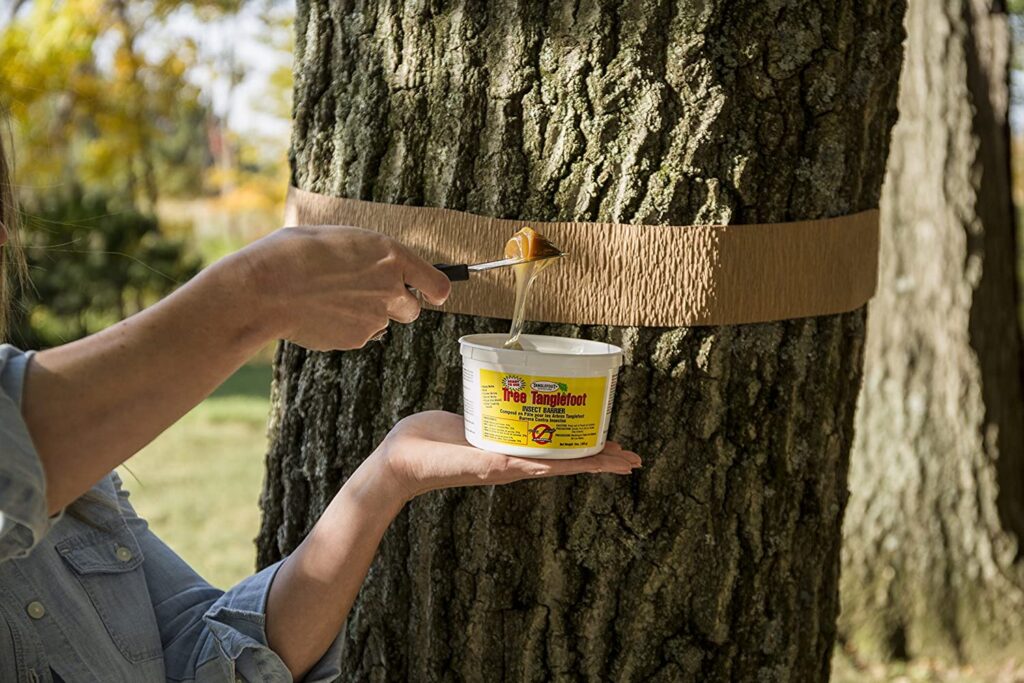
Tree tanglefoot to trap the earwigs and other young crawlers of pests
Use Diatomaceous Earth to Eliminate Earwigs
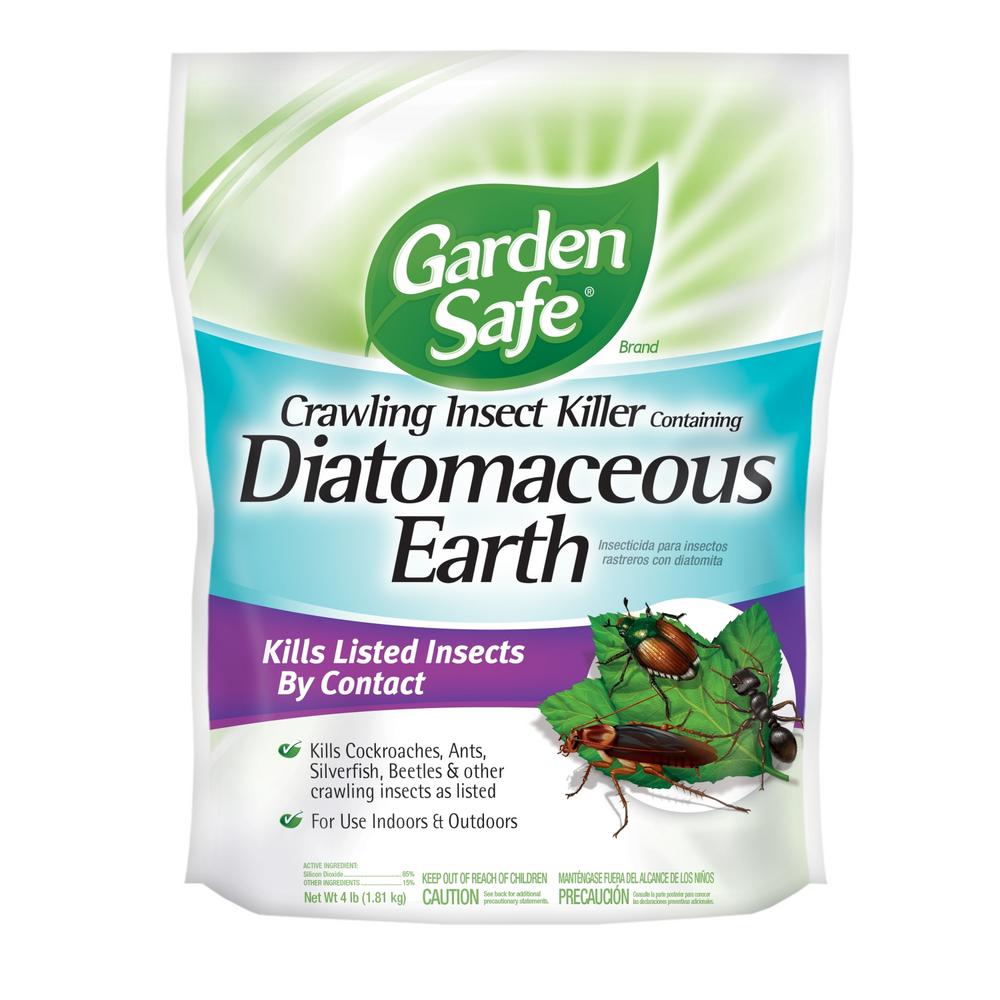
Diatomaceous earth kills earwigs and protects plants
Apply diatomaceous earth (DE) for the best and long-lasting protection against earwigs. It is a fine white powder that consists of fossilized diatoms—a type of hard-shelled algae. DE works as an earwig pesticide because it penetrates the insect body, such as slugs, snails, and earwigs, and causes a loss in body moisture.
Reapply DE after rain and make sure the areas are dry. The applications of this powder ensure the best, most natural, and non-toxic pest control method and provide long-lasting results.
Use Insect Killer Granules
Apply the insect killer powders or granules to kill earwigs and other pests such as black ants, centipedes, scorpions, fleas, ticks, and spiders. These granules work fastly and kill earwigs through contact. Each 4.5 kg of insect kill granules treats 5 000 square feet.
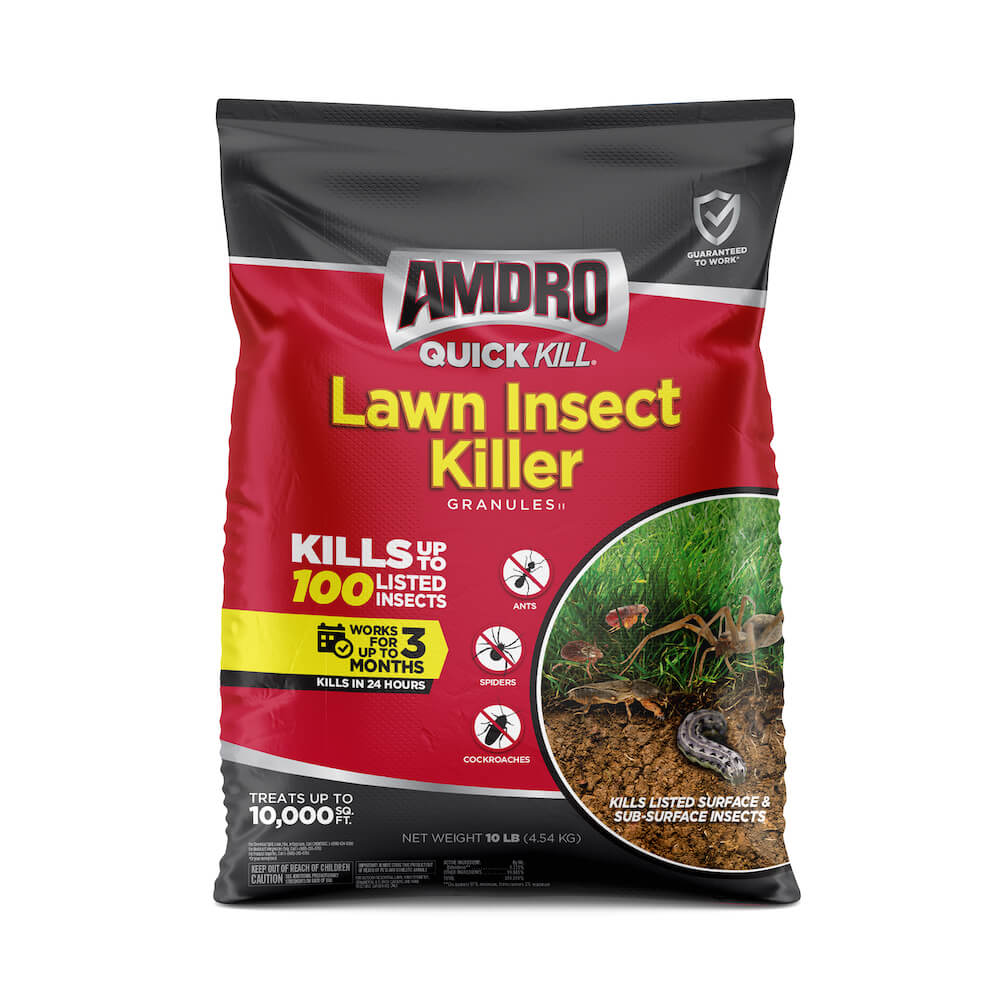
Quick action against earwigs and other plant harming pests
Spread the granules near foundations, near your lawn, and gardens as 2 to 5 pounds per 1000 square feet of area. The best thing about this product is that it is safe around humans and pets. It contains clove oil, thyme oil, wintergreen oil, and peanut shells to repel and kill earwigs.
Use Botanical Pesticides to Eliminate Earwigs
The application of plant origin or synthetic chemicals is considered a last resort to control earwigs. Use these botanical pesticides when the populations of earwigs are higher, and they are responsible for the tremendous amount of damage.
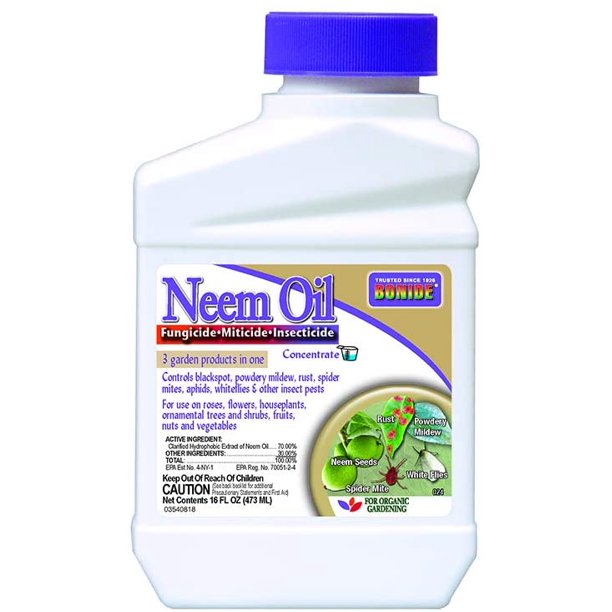
Neem oil spray to ensure the protection against pincher bugs
Neem oil spray functions as a suffocating agent and helps get rid of earwigs instantly.
How to Get Rid of Earwigs? A Useful Guide by Solutions Pest & Lawn
Use Boric Acid Powder to Prevent Earwigs Damage
The boric acid powder is a natural insecticide and works against many insects. Therefore, to get rid of earwigs, spread the boric acid powder in spots and underground nests where you find them to crawl through it.
Be careful to keep boric acid away from children and pets.
Use Soy Sauce Traps Against Earwigs
Take a few drops of vegetable oil and two cups of soy sauce in a jar and mix them thoroughly. Place the jars at spots where you suspect the activity of earwigs, and they will trap in them due to the smell of soy sauce.
Use Soapy Water to Eliminate Earwigs
Mix mild liquid dish soap and water in a bowl and then pour into a spray bottle to spray down the areas where you find them or their activity.
FAQs
Do Ladybugs Eat Earwigs?
Like many other garden pests, the earwigs do not have any natural predators that feed on them, such as ladybugs, green lacewings, beneficial nematodes, and parasitic wasps.
At the same time, the earwigs act as beneficial insects and feed on aphids, their larvae, and the eggs of other garden pests. Thus, helping the growers keep their plants healthy.
What Causes the Earwigs?
Earwigs like damp areas, sheltered places, and the mulches of your garden. They are also present on the underside of potted plants due to excess moisture.
Along with these conditions, the ample food supply will also attract earwigs to your garden. Most importantly, they are only considered harmful pests when their numbers in gardens are high and the damage exceeds from foliage to flowers.
Other than decaying plant material, their favorite food is aphids and larvae of slow-moving bugs. Earwigs eat armyworm, their eggs, and snails.
What Are the Host Plants of Earwigs?
The host plants for earwigs are roses, fruit trees, herbs, marigolds, dahlias, zinnias, apricots, peaches, and berries. Earwigs eat these plants’ foliage, flowers, and fruit and lead to poor fruit development. In other words, their feeding impacts the cosmetic value of fruits.
How Do You Get Rid of Earwigs Instantly?
There are two ways to get rid of earwigs instantly, and these are,
- Use of insect killer granules
- Vegetable oil and soy sauce traps
Applying insect killer granules kills earwigs because it penetrates their body and causes moisture loss. Moreover, its applications are non-toxic to humans, pets, and the environment.
On the other hand, the soy sauce smell attracts the earwigs, and they quickly get trapped in the traps.
What Essential Oils Deter Earwigs?
These oils are effective against earwigs.
- Clove oil
- Peppermint oil
- Cinnamon oil
- Cedar oil
- Eucalyptus oil
- Lavender oil
- Basil oil
How Do You Get Rid of Earwigs in Your House?
The earwigs do not thrive and survive in indoor environments, and their presence in homes is only occasional. However, if somehow, they manage to enter your home and cause trouble, the best way is to treat them with soapy water and sticky traps.
These two methods are best for instant management of earwigs. Moreover, the regular cooking oil and soy sauce also make an effective trap against earwig infestations.
How Long Does an Earwig Live?
The average lifespan of an adult earwig is one year with two generations. They overwinter in the soil, and the mating season for earwigs is in autumn and winter. The hatching time is early spring, and nymphs undergo 4 to 5 molt stages to turn into adults.
Sources for Further Reading
- Planet Natural. (2019a, May 17). How to Get Rid of Earwigs. Retrieved April 12, 2022, from https://www.planetnatural.com/pest-problem-solver/garden-pests/earwig-control/
- Flint, M. L. (2012, November). Earwigs Management Guidelines–UC IPM. University of California Agriculture and Natural Resources. Retrieved April 12, 2022, from http://ipm.ucanr.edu/PMG/PESTNOTES/pn74102.html
- Cooperative Extension: Insect Pests, Ticks, and Plant Diseases. (2021a, August 30). Earwigs – Cooperative Extension: Insect Pests, Ticks and Plant Diseases – University of Maine Cooperative Extension. Retrieved April 12, 2022, from https://extension.umaine.edu/ipm/ipddl/publications/5017e/
- McKie, P., & Skelly, J. (2001). Earwigs. Extension | University of Nevada, Reno. Retrieved April 12, 2022, from https://extension.unr.edu/publication.aspx?PubID=3259
Now that you know how to get rid of earwigs, make sure to check out our other articles:
How to Get Rid of Bugs in Plants? Plus Their Identification & Effective Management!
Are Japanese Beetle Traps Helpful for Organic Pest Management?
Best Worms For Composting: Its Basics and Guide for Beginners!







